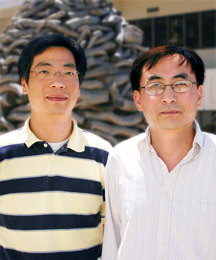

Team Discovers Critical Component in the Progression of Inflammation
By Mark Shrope
Sepsis, like other inflammatory diseases, is an often fatal condition that triggers a runaway immune system response. Although strides have been made in recent years, current treatments for these diseases remain inadequate, with about a third of sepsis cases leading to death. Progress toward developing better treatments has been chronically hampered by a lack of understanding of even some of the most basic processes involved.
The group of Professor Jiahuai Han in The Scripps Research Institute's Department of Immunology has been working to eliminate that deficiency, and they have just made a major advancement in the quest. Working with colleagues from Canada and Korea the team has discovered a critical component in the biochemical cascade that causes the inflammatory immune system to go into overdrive. The work, which appeared online in Nature Immunology on May 14, could aid in the development of new treatments for inflammatory diseases.
This recent research focuses on the role of macrophages, which are white blood cells that can engulf and kill infectious microorganisms. Receptors on the surface of a macrophage can recognize molecules on the surface of certain invading bacteria, triggering a complex biochemical cascade that leads to the production of proteins known as cytokines, leading to inflammation, and triggering the down regulation that ends an immune response.
An immune response is, of course, beneficial to a point, because it coordinates an attack against invading bacteria. With conditions like sepsis, a response is clearly warranted, because the disease is a bacterial infection of the blood, often caused when bacteria enter the body through a cut. However, for reasons that have remained unclear, at times this initially helpful response continues unabated, becoming a form of "friendly fire" that ultimately leads to the destruction of healthy cells, and various associated and potentially deadly complications.
Scientists have struggled for years to understand what causes the shift from helpful to runaway response. "There really have not been too many ideas about why it continues for so long," says Han. But he and his group have now found what appears to be a critical component in the process.
One of the proteins that an immune response can produce is called 4-1BBL, which is involved in the inflammatory response to invading bacterial component, lipopolysaccharide. The Han group worked with mice genetically altered to lack this and related immune system compounds to elucidate the functions of each. They discovered that 4-1BBL, already recognized as playing a role in stimulating white blood cells to action, also has a critical and previously unknown function.
The 4-1BBL, once its expression is induced inside the macrophage, can travel to the macrophage surface, where it interacts with the same receptors that recognize bacteria to initiate the immune response. When 4-1BBL binds with those receptors, it sets off a second and different signaling cascade that results in the production of the cytokines that appear responsible for the dangerous, sustained immune response.
The team was also able to identify other molecules important in this new cascade, namely two proteins known as CREB and C/EBP. Certain other key players in the chemical chain remain unknown, but hopefully not for long. "That's what we have to find out," says Young Jun Kang, a research associate in the Han lab and lead author on the Nature Immunology paper. Another key goal for the group will be to understand how the 4-1BBL signaling cascade is regulated.
Increased understanding of the factors controlling inflammatory response may ultimately help researchers to develop new life-saving treatments for sepsis and other diseases. "There are still a lot of places to go," says Kang.
One broad target might be to block the 4-1BBL cascade, though this could be a complicated prospect because this same process that sustains damaging inflammation might also be beneficial in its early stages.
Kang says the group would also like to expand its research scope. "At the moment we are limited to infectious diseases," he says, "but hopefully we can eventually broaden to all the inflammation-related conditions." One such logical focus would be arthritis, especially rheumatoid arthritis, which involves many of the same processes utilized by the immune system. A receptor for 4-1BBL, for instance, is already known to play a role in that crippling disease.
In addition to Kang and Han, authors on the Nature Immunology paper, titled "Cell surface 4-1BBL mediates sequential signaling pathways 'downstream' of TLR and is required for sustained TNF production in macrophages," were Sung Ouk Kim, from the University of Western Ontario, Shigeki Shimada, Motoyuki Otsuka, and Alim Seit-Nebi from Scripps Research, Byoung S. Kwon from Korea's University of Ulsan, and Tania Watts, from the University of Toronto.
This research was supported by the National Institutes of Health, the Canadian Institutes of Health, the Science Research Center Fund from the Korea Science and Engineering Foundation, and a Grant-in-Aid for the 21st Century Center of Excellence Program Topological Science and Technology from the Ministry of Education, Culture, Sport, Science, and Technology of Japan.
Send comments to: mikaono[at]scripps.edu
 Professor Jiahuai Han (right) and Research Associate Young Jun Kang are authors of the Nature Immunology paper. Photo By Kevin Fung.
Professor Jiahuai Han (right) and Research Associate Young Jun Kang are authors of the Nature Immunology paper. Photo By Kevin Fung.
